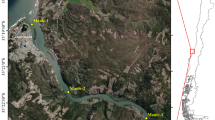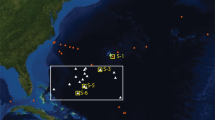Abstract
It is shown that, in 2002–2005, the mass development of the coccolithofore Emiliania huxleyi on the Gelendzhik shelf occurred annually and in May–June its abundance reached 1.5 × 106 cells/l. In 2004–2005, the bloom of E. huxleyi was accompanied by a mass development of the diatom alga Chaetoceros subtilis var. abnormis f. simplex (0.6–0.9 × 106 cells/l); for the first time, it was registered as a dominating form of the Black Sea phytoplankton. Small flagellates and picoplankton algae played a noticeable role in the phytoplankton throughout the entire period of the studies. Meanwhile, in the early summer period, the bulk of the biomass consisted of coccolithophores (50–60%), while, in the late summer period, diatomaceous algae dominated (50–70%). Among the ecological factors that favor the coccolithophore development one may note the microstratification of the upper mixed layer at a high illumination level and high temperature in the surface waters (18–21°C). The terrigenous runoff during the rainy period had a negative effect on the E. huxleyi development, while storms dispersed the population over the upper mixed layer. The wind-induced near-shore upwelling stimulated the development of diatoms.
Similar content being viewed by others
References
A. O. Vershinin, A. A. Moruchkov, I. N. Sukhanova, et al., “Seasonal Changes in the Phytoplankton in the Area of Cape Bol’shoi Utrish off the Northern Caucasian Coast of the Black Sea, 2001–2002,” Okeanologiya 44(3), 399–405 (2004) [Oceanology 44 (3), 372–378 (2004)].
M. E. Vinogradov and E. A. Shushkina, Functioning of Epipelagic Planktonic Communities of the Ocean, Ed. by K. N. Nesis (Nauka, Moscow, 1987) [in Russian].
L. I. Georgieva, “Species Composition and Dynamics of the Phytocoenosis,” in Plankton of the Black Sea, Ed. by A. V. Kovalev and Z. Z. Finenko (Naukova dumka, Kiev, 1993), pp. 31–55 [in Russian].
V. V. Zernova, “Seasonal Changes in the Species Structure of the Phytococenosis in the Northeastern Part of the Black Sea,” in Marine Phytoplankton Ecology, Ed. by G. I. Semina (IO AN SSSR, Moscow, 1981), pp. 43–64 [in Russian].
V. V. Zernova and N. P. Nezlin, “Seasonal Changes in the Species Structure of the Phytococenosis in the Northeastern Part of the Black Sea in 1978,” in Seasonal Changes in the Black Sea Plankton, Ed. by Yu. I. Sorokin and V. I. Vedernikov (Nauka, Moscow, 1983), pp. 12–34 [in Russian].
I. A. Kiselev, Plankton of Seas and Inland Basins (Nauka, Leningrad, 1969), Vol. 1 [in Russian].
Z. N. Mikhailovskaya, “Phytoplankton of Novorossiisk Bay and Its Vertical Distribution,” Tr. Novoross. Biol. stantsii im. V. M. Arnol’di 2(1) 37–54 (1936), pp. 37-54 [in Russian].
M. I. Roukhiyainen, “On the Seasonal Dynamics of the Black Sea Phytoplankton,” in Marine Biology, Ed. by V. N. Greze (Naukova dumka, Kiev, 1973), pp. 150–161 [in Russian].
L. G. Senichkina, L. V. Georgieva, D. A. Nesterova, et al., “Phytoplankton of the Black Sea in the Summer of 1989: Biomass and Its Relation to the Hydrological Setting,” in Variability of the Black Sea Ecosystem. Natural and Anthropogenic Factors, Ed. by M. E. Vinogradov (Nauka, Moscow, 1991), pp. 104–116 [in Russian].
I. N. Sukhanova, “Concentrating Phytoplankton in a Sample,” in Modern Methods for Quantitative Estimation of the Distribution of Marine Phytoplankton, Ed. by M. E. Vinogradov (Nauka, Moscow, 1983), pp. 97–105 [in Russian].
I. N. Sukhanova, “Phenomenon of Mass Development of Coccolithophores in the Late Autumn Period in the Black Sea,” Dokl. Akad. Nauk 340(4), 256–259 (1995).
I. N. Sukhanova and M. V. Flint, “Anomalous Blooming of Coccolithophorids over the Eastern Bering Sea Shelf,” Okeanologiya 38(5), 557–560 (1998) [Oceanology 38 (4), 5027–505 (1998)].
I. N. Sukhanova, M. V. Flint, T. E. Whitledge, and E. J. Lessard, “Coccolithophorids in the Phytoplankton of the Eastern Bering Sea Shelf after the Anomalous Bloom of 1997,” Okeanologiya 44(5), 709–722 (2004) [Oceanology 44 (5), 665–678 (2004)].
E. A. Shushkina, M. E. Vinogradov, L. P. Lebedeva, and T. A. Lukasheva, “Zooplankton Distribution on the Shelf of the Northeast Black Sea in the Warm Climatic Period of 2000–2002,” Okeanologiya 44(4), 524–537 (2004) [Oceanology 44 (4), 489–502 (2004)].
R.-H. Baumann, H. Andruleit, B. Bockel, et al., “The Significance of Extant Coccolithophores As Indicator of Ocean Water Masses, Surface Water Temperature, and Paleoproductivity: A Rewiew,” PaleontologischeZeitschrift 79, 93–112 (2005).
T. Cokacar, N. Kubilay, and T. Oguz, “Structure of Emiliania huxleyi Blooms in the Black Sea Surface Waters As Detected by SeaWIFS Imagery,” Geophys. Res. Lett. 28, 4607–4610 (2001).
E. Eker, L. Georgieva, L. Senichkina, and A. E. Kideys, “Phytoplankton Distribution in the Western and Eastern Part of Black Sea in Spring and Autumn 1995, ICES,” J. of Marine Systems 56 (2003).
J. K. Egge and B. R. Heimdal, “Blooms of Phytoplankton Including Emiliania huxleyi (Haptophyta). Effects of Nutrient Supply in Different N: P Ratios,” Sarsia 79, 333–348 (1994).
Identifying Marine Phytoplankton, Ed. by C.R. Tomas (Academic Press, San-Diego, 1997).
M. D. Iglesias-Rodrigez, C. W. Brown, S. C. Doney, et al., “Representing Key Phytoplankton Functional Groups in Ocean Cycle Models: Coccolithophorids,” Global Biogemical Cycles 16(4), 1–20 (2002).
V. G. Krivosheya, V. G. Yakubenko, L. V. Moskalenko, and A. Yu. Skirta, “Features of Interannual Variability of Water Dynamics and Hydrological Structure in the Active Layer in the Northeastern Part of the Black Sea from 1990 to 2004,” Oceanology 45(Suppl. 1) S3–S12 (2005).
E. J. Lessard, A. Merico, and T. Tyrell, “Nitrate: Phosphate Ratios and Emiliania huxleyi Blooms,” Limnol. Oceanogr. 50, 1020–1024 (2005).
A. S. Mikaelyan, L. A. Pautova, S. I. Pogosyan, and I. N. Suchanova, Summer Bloom of Coccolithophorids in the Northeastern Black Sea,” Oceanology 45(Suppl. 1), S27–S38 (2005).
H. J. Nanninga and T. Tyrrell, “The Importance of Light for the Formation of Algal Blooms by Emiliania huxleyi,” Mar. Ecol.: Proc. Ser. 136, 195–203 (1996).
E. Paasche, “A Review of the Coccolithophorid Emiliania huxleyi (Prymnesiophyceae), with Particular Reference to Growth, Coccolith Formation, and Calcification-Photosynthesis Interactions,” Phycologia 40, 503–529 (2001).
U. Riebesell, “Effects of CO2 Enrichment on Marine Phytoplankton,” J. of Oceanography 60, 719–729 (2004).
R. Riegman, W. Stolte, A. A. M. Noordeloos, and D. Slezak, “Nutrient Uptake, and Alkaline Phosphate (EC 3: 1: 3: 1) Activity of Emiliania huxleyi (Prymnesiophyacea) During Growth Under N and P Limitation in Continuous Cultures,” J. Phycol. 36, 87–96 (2000).
T. Tyrrell and A. H. Taylor, “A Modelling Study of Emiliania huxleyi in the NE Atlantic,” J. of Marine Systems 9, 83–112 (1995).
I. Zondervan, B. Rost, and U. Riebesell, “Effect of CO2 Concentration on the PIC/POC Ratio in the Coccolithophore Emiliania huxleyi Grown Under Light-Limiting Conditions and Different Daylengths,” J. of Experimental Marine Biology and Ecology 272, 55–70 (2002).
Author information
Authors and Affiliations
Additional information
Original Russian Text © L.A. Pautova, A.S. Mikaelyan, V.A. Silkin, 2007, published in Okeanologiya, 2007, Vol. 47, No. 3, pp. 408–417.
Rights and permissions
About this article
Cite this article
Pautova, L.A., Mikaelyan, A.S. & Silkin, V.A. Structure of plankton phytocoenoses in the shelf waters of the northeastern Black Sea during the Emiliania huxleyi bloom in 2002–2005. Oceanology 47, 377–385 (2007). https://doi.org/10.1134/S0001437007030101
Received:
Accepted:
Issue Date:
DOI: https://doi.org/10.1134/S0001437007030101




